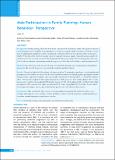Please use this identifier to cite or link to this item:
https://hdl.handle.net/20.500.14356/1710Full metadata record
| DC Field | Value | Language |
|---|---|---|
| dc.contributor.author | Joshi, L R | - |
| dc.date.accessioned | 2023-05-19T05:47:23Z | - |
| dc.date.available | 2023-05-19T05:47:23Z | - |
| dc.date.issued | 2015 | - |
| dc.identifier.citation | JoshiL. R. (2016). Male Participation in Family Planning: Human Behaviour Perspective. Journal of Nepal Health Research Council. https://doi.org/10.33314/jnhrc.v0i0.670 | en_US |
| dc.identifier.issn | Print ISSN: 1727-5482; Online ISSN: 1999-6217 | - |
| dc.identifier.uri | http://103.69.126.140:8080/handle/20.500.14356/1710 | - |
| dc.description | Original Article | en_US |
| dc.description.abstract | Abstract Background: Family planning (FP) is one of the major components of reproductive health and its goal is to preventunwanted pregnancies and regulate wanted pregnancies, thereby ensuring the health of mothers and children. It alsoaims at regulating the population in order to maintain the vital balance between development and the environment.Ideally, FP depends on the efforts of a couple where the man and woman are equally responsible and accountable. Inreality, however, this is not the case. It is in this background that the present study aims at examining the nature and level of male participation in preventing unwanted pregnancies and the factors that influence male participation in FP. Methods: The data for the study was derived using mixed methods, drawing from both quantitative and qualitativeapproaches. The research design was cross-sectional, descriptive and observational. Results:Â Despite the high level of knowledge and awareness about FP among the respondents, it was found that maleparticipation in FP continues to remain very low. The multidimensional factors influencing their participation includeeducation of the couple (the unadjusted odds ratio of higher education level of respondents is 2.182 and the adjustedOR is 1.972; and the unadjusted OR of higher education level of the spouse is 2.030, and the adjusted OR is 1.570),and economic condition (the unadjusted OR of higher income is 2.272 and the adjusted OR is 2.436) of family. Maleparticipation in FP was found to be higher in rural areas (69.8 %) and among Dalits (72.5%). Other factors include social stigma and religious practice, patriarchal notions, gender roles and individual characteristics. Â Conclusions: Male participation plays a crucial role in population management, but patriarchal notions, socio culturally defined gender roles, combined with the inefficiency of the current FP programme, and biologicalfactorscontribute towards keeping male participation very low. | en_US |
| dc.language.iso | en_US | en_US |
| dc.publisher | Nepal Health Research Council | en_US |
| dc.relation.ispartofseries | Sep-Dec, 2015;670 | - |
| dc.subject | Family planning | en_US |
| dc.subject | Male participation | en_US |
| dc.subject | Masculinity | en_US |
| dc.subject | Human behaviour | en_US |
| dc.title | Male Participation in Family Planning: Human Behaviour Perspective | en_US |
| dc.type | Journal Article | en_US |
| local.journal.category | Original Article | - |
| Appears in Collections: | Vol. 13 No 3 Issue 31 Sep-Dec 2015 | |
Files in This Item:
| File | Description | Size | Format | |
|---|---|---|---|---|
| 670-Article Text-1260-1-10-20160317.pdf | Full text Article | 189.72 kB | Adobe PDF |  View/Open |
Items in DSpace are protected by copyright, with all rights reserved, unless otherwise indicated.
